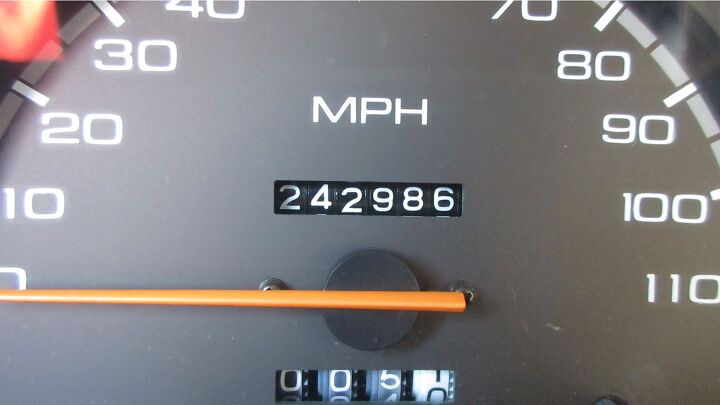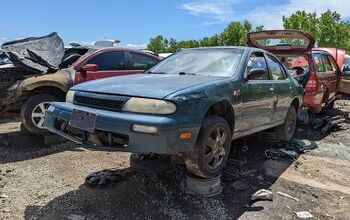451 Views
Junkyard Find: 1993 Isuzu Amigo

by
Murilee Martin
(IC: employee)
Published: December 18th, 2017
Share
The family tree of the Isuzu Faster pickup, best known in North America as the Chevrolet LUV, developed a thick branch of models that included some decent-selling SUVs. The two-door Amigo was the first of these to hit our shores.Here’s a high-mile example spotted in a San Francisco Bay Area self-service wrecking yard.
This Amigo is a rear-wheel-drive model with five-speed manual and air conditioning. Its California smog-check records show passed biennial emissions tests going back to the middle 1990s, so it appears to have been a reliable commuter machine, racking up more than 10,000 Golden State highway miles each year.
The Amigo’s four-door big brother, the Rodeo, could be had with a GM 3.1-liter V6 in 1993, but Amigo drivers had to accept the 119-horse, 2.6-liter straight-four.
It’s vaguely outdoorsy-looking, but it’s likely nearly all of its miles were spent in stop-and-go traffic on the deteriorating tarmac of California’s roads. Part of the reason for the death of the manual transmission in the American market is the preference for as little left-leg activity as possible during an 11-mile/90-minute commute, but the driver(s) of this car lived with the five-speed. In any case, the Amigo had a sportier image than, say, a 1993 Honda Del Sol, and perhaps that eased the pain of those hundreds of thousands of 0.75 mph clutch applications.
The interior and cloth top are in pretty good condition, indicating that this Amigo’s owner or owners garaged it for most of its life. I didn’t see any major crash damage, so an expensive mechanical failure is the likely culprit that doomed this truck.
{
"id": "9199827",
"alt": "",
"title": "",
"video_link": "https://www.youtube.com/embed/bRnT-TklALk",
"youtube_video_id": "bRnT-TklALk"
}
{
"width": 634,
"height": 357,
"showRelated": true
}
The first-generation Amigo was sold in the United States for the 1989 through 1995 model years (it returned in 1998), and this retro commercial riffs on the brain-scrambling Slinky ads of two decades earlier.
#1990s
#1993
#1993IsuzuAmigo
#Amigo
#California
#DownOnTheJunkyard
#Isuzu
#IsuzuAmigo
#IsuzuMU
#IsuzuRodeo
#Junkyard
#JunkyardFind
#Rodeo

Murilee Martin
Murilee Martin is the pen name of Phil Greden, a writer who has lived in Minnesota, California, Georgia and (now) Colorado. He has toiled at copywriting, technical writing, junkmail writing, fiction writing and now automotive writing. He has owned many terrible vehicles and some good ones. He spends a great deal of time in self-service junkyards. These days, he writes for publications including Autoweek, Autoblog, Hagerty, The Truth About Cars and Capital One.
More by Murilee Martin
Published December 18th, 2017 8:00 AM
Latest Car Reviews
Read moreLatest Product Reviews
Read moreRecent Comments
- FreedMike I guess they didn't get invited to the ride and drive event.
- NotMyCircusNotMyMonkeys still DDing a 2006 scion xA bought new. newly single later that year and ive managed to keep it that way :)dogs are awesome.
- ToolGuy "I can't point you to a link to my Jalopnik review of the 2008 Sable Premier, because it never went live on the site due to disagreements with editors over how I'd structured the piece. 16½ years later, all I can recall is that I removed door panels to examine the build quality of hidden electrical connectors and window-regulator mounting hardware, and that I thought Ford had improved greatly in those departments since the 1990s."• This is a great paragraph. (I could support this style of automotive journalism.)
- Kwik_Shift_Pro4X Loony left strikes again.
- Honda1 It's time to deal with these punk protestors/disruptors in a more "meaningful" way. Whether it be at Tesla in Germany or any one of the schools in the US, the time has come for these professional punks to be held accountable by any means. This shyt has to stop!

















































Comments
Join the conversation
A 2.6 liter 4 with 119 horsepower in a vehicle from 1993 sounds like a complete dog, to be honest...
Out of curiosity: Is it normal for an owner to not remove the plates on a vehicle destined for a wrecking yard? I was surprised to see the front plate on the passenger seat and the rear plate looking as though it was "ripped" off the rear (instead of just removing the mounting screws holding it on). We get a credit if we turn in plates from a vehicle that is being disposed of in this manner (or at least we used to).